By Sarah Galt, OD, FAAO

Nov. 13, 2019
Children can present a variety of challenges in the optometric exam room. A subjective adult eye exam can be modified to obtain reliable, objective outcomes from your pediatric patient.
Here are a few pediatric pearls to keep in mind when growing your younger patient population.
Kids Aren’t Always a Challenge, But It Can Sometimes Be Hard Determining Needs
A big surprise when adding pediatric patients to your schedule is how easy they can be! While children vary in temperament, and can have altered behavior based on the timing of the exam in respect to food and sleep, they are eager to please and can perform many portions of a standard adult exam without much alteration or extra time.
A challenging surprise presents when a child is not feeling their best. Whether they are tired, hungry or shy, it may be difficult to extract reliable information out of them. Having your staff present the expected duration of the exam when confirming the appointment can aid the parent in having snacks, naps and favorite toys managed ahead of exam time.
Other Articles to Explore
For parents and patients it is beneficial to provide a verbal framework of the exam and each portion prior to beginning it. For example, after dilation when welcoming the patient back into the room, I will often say “Great job taking a break, we only have two more parts of the exam left!”
I will then show them the phoropter, explain that we will sing the ABC’s while looking through this machine, and then I will put on my “robot hat” to look inside their eyeballs. This process of explanation is particularly important with patients with Autism Spectrum Disorder or other neuro-divergences.
You May Need to Rely on Objective Examination Techniques
A complete and thorough eye exam can be performed objectively. It is important to maintain your skills with retinoscopy, particularly loose lens retinoscopy, even though you may be able to successfully examine the majority of your patients with a traditional refraction.
When obtaining loose lens ret on non-verbal patients of any age, if a low plus lens appears neutral, do not stop there. It is important to confirm by finding a streak in either the plus or minus direction. A +9.00 D eye may appear neutral with a +1.50 in front of it, but if you hold up a +5.00 and see a “with-motion” streak you know to continue with more plus. A few times a year I have a concerned parent seek a second opinion after being told that their child does not need glasses, and end up finding that +9.00 D or -13.00 D prescription.
It is also important to remember that obtaining a view of the posterior pole is worthwhile even if it leads to tears and tantrums. In light sensitive or very shy patients, after a few unsuccessful views, try songs, fun lights and toys or “1-2-3 OPEN!”
I will request the parent to sandwich the patient’s ears with flat hands while I open their lids and obtain the needed view. The tears that follow are quickly allayed with distracting conversation or stickers. It is important that you thoroughly communicate the importance of and reason for obtaining the view with a parent before restraining, or otherwise manipulating, a patient to obtain BIO views or retinoscopy.
The take home message here is: do not shy away. Reliable values can be obtained from difficult patients with alteration of exam techniques, patience and perception of how to best communicate with your patient.
Key factors of the pediatric exam are all the same as with an adult and can be obtained objectively. These are, at minimum, gross visual field, ocular alignment, refractive error and posterior pole ocular health, acuity, IOP, basic neurologic exam (eg: pupils, EOMs, eye-lid symmetry & function) as well as anterior.
Build Skills & Acknowledge When the Child Needs More than You Can Provide
If it has been a while since your pediatric clinic in optometry school, you haven’t seen children patients in a while, and you would like to build your pediatric population, shadowing another doctor with a high pediatric volume can be beneficial. It is possible to obtain experience communicating with and evaluating a large volume of pediatric patients by volunteering at a vision screening in your community.
Even with the best preparation, there may be times when you feel you are not able to reliably obtain data for a patient. An OD be should aware of, and have relationships with, local optometrists specializing in pediatrics and pediatric ophthalmology practices, and to refer out when as needed.
Whenever there is a lack of confidence in measurements taken in your office, or expected results are not obtained from patching, prism, or other interventions, a second opinion should be sought. This does not mean giving up the patient, as any specialist should keep open lines of communication and send the patient back after providing needed care. Know when your scope of practice has reached its limit, and provide appropriate referrals for consults.
Editor’s note: Because of the high percentage of pediatric malpractice cases that are misdiagnosed amblyopia, always remember that amblyopia is a diagnosis of exclusion – you have to exclude everything else before you can make that diagnosis. A key point to keep in mind is to ensure your diagnosis is accurate before beginning intervention such as patching.
The pediatric population is a great source of practice growth. When a patient has a positive experience, their siblings and parents will often become patients as well. A happy family who returns annually is very worth some of the challenges of pediatric examination.
 Sarah Galt, OD, FAAO, is an associate at Bright Eyes Vision Clinic–All About Kids Vision. To contact her: galt.sarah@gmail.com
Sarah Galt, OD, FAAO, is an associate at Bright Eyes Vision Clinic–All About Kids Vision. To contact her: galt.sarah@gmail.com





















